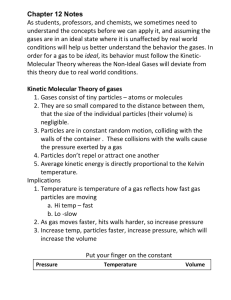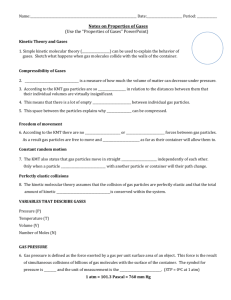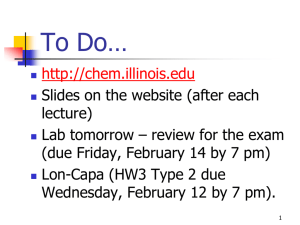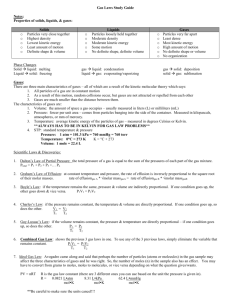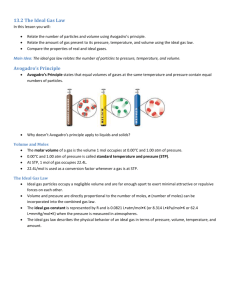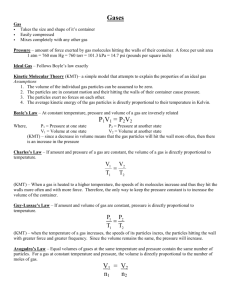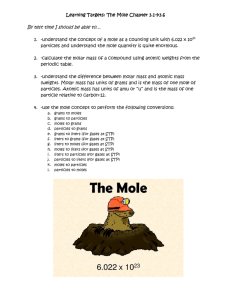The Gas Laws - Waterford Public Schools
advertisement
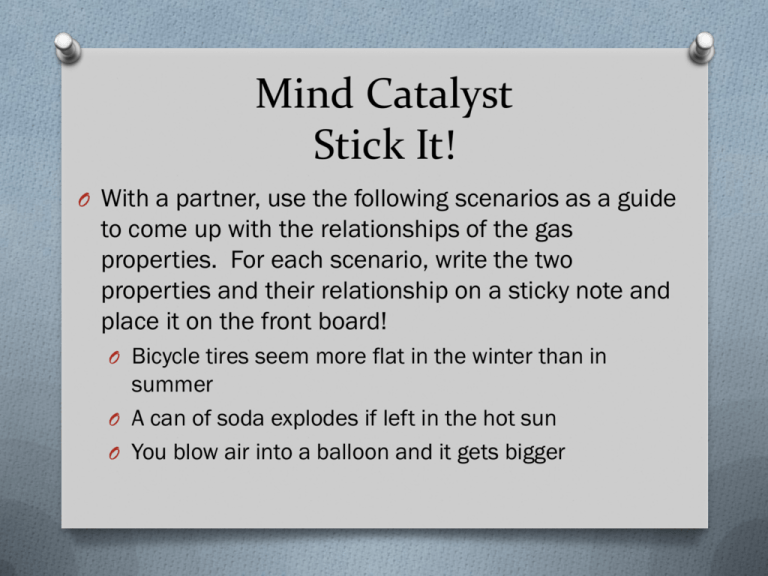
Mind Catalyst Stick It! O With a partner, use the following scenarios as a guide to come up with the relationships of the gas properties. For each scenario, write the two properties and their relationship on a sticky note and place it on the front board! O Bicycle tires seem more flat in the winter than in summer O A can of soda explodes if left in the hot sun O You blow air into a balloon and it gets bigger The Kinetic Molecular Theory and its Relation to the Gas Laws Robert Boyle Jacques Charles Amadeo Avogadro Joseph Louis Gay-Lussac The Kinetic Molecular Theory of Gases O In the simulation, you personally observed the behavior of an ideal gas but not why they behave as they do O Why does a gas expand when heated at constant pressure? O Why does the pressure increase when a gas is compressed at constant temperature? O To understand the physical properties of gases, we need a model that helps us picture what happens to gas particles when conditions such as pressure or temperature change O This model is known as the kinetic-molecular theory of gases Gases and the Kinetic Molecular Theory Model O All particles are in constant, random motion O All collisions between particles are perfectly elastic O The volume of the particles in a gas is negligible O The average kinetic energy of the molecules is in its Kelvin temperature Why do We Care? O Assumptions of the KMT successfully account for the observed behavior of an ideal gas O In reality, real gases have a finite volume and exhibit attractive forces between other gas molecules O But now, we must ask the question: “How do these assumptions explain your observations?” The KMT and the Relationship between Pressure and Volume O You observed that as the volume of the container decreased, the pressure of the gas increased (at constant temperature and amount of gas) O This is due to the gas particles hitting the wall more often O As a result, the force exerted on the walls of the container increases O This inverse relationship is referred to as Boyle’s Law Introducing Boyle’s Law P Volume (mL) Pressure (torr) P·V (mL·torr) 10.0 20.0 30.0 40.0 760.0 379.6 253.2 191.0 7.60 x 103 7.59 x 103 7.60 x 103 7.64 x 103 PV = k V The KMT and the Relationship between Volume and Temperature O You observed as heat was applied to the gas particles (at constant pressure and amount of gas), the temperature increased and volume of the container increased O This is because the speed of the gas particles increased and thus, hit the walls more often and with more force O Only way to keep pressure constant is to INCREASE the VOLUME of the container! O This direct relationship is referred to as Charles’ Law Introducing Charles’ Law V T Volume (mL) Temperature (K) V/T (mL/K) 40.0 44.0 47.7 51.3 273.2 298.2 323.2 348.2 0.146 0.148 0.148 0.147 V k T The KMT and the Relationship between Pressure and Temperature O You observed that when the temperature of a gas increases, the speeds of its particles increase O The particles are hitting the wall with greater force and greater frequency O Since the volume remains the same, this would result in INCREASED gas pressure O This direct relationship is referred to Amonton’s Law Introducing Amonton’s Law P k T The KMT and the Relationship Between Volume and the Amount of a Gas O You observed that an increase in the number of particles at the same temperature would cause the pressure to increase if the volume were held constant O The only way to keep constant pressure is to vary the volume the same way! O This direct relationship is referred to as Avogadro’s Law O Another way to express this relationship is that equal volume of all ideal gases at the same temperature and pressure contain the same number of molecules O This relationship is important because you may think a small gas molecule would take up less space than a large gas molecule O But , it doesn’t at the same temperature and pressure! Introducing Avogadro’s Law Gas O2 N2 CO2 Volume (mL) 100.0 100.0 100.0 Mass (g) 0.122 0.110 0.176 Moles, n 3.81 10-3 3.93 10-3 4.00 10-3 V/n (L/mol) 26.2 25.5 25.0 V k n V n Illustration of Avogadro’s Law A Summary of the Four Gas Laws O Boyle’s law PV = k (at constant T and n) O Charles’ law O Amonton’s law O Avogadro’s law V =k T (at constant P and n) P =k T (at constant V and n) V =k n (at constant T and P) The Ideal Gas Law Who’s got time to remember all four of those relationships? NOT ME! O So, the previous 4 relationships can be combined into one very important equation called the ideal gas law: O PV = nRT O R is the combined proportionality constant called the universal gas constant O Always use the value 0.0821 O 𝐿∙𝑎𝑡𝑚 for R 𝐾∙𝑚𝑜𝑙 The ideal gas law is an equation of state for a gas O State of a gas is its condition at a given time O A particular state of a gas is described by its pressure, volume, temperature, and number of moles O A gas that obeys this equation is said to behave ideally Practice! O A sample of hydrogen gas (H2) has a volume of 8.56 L at a temperature of 0°C and a pressure of 1.5 atm. O Calculate the moles of H2 molecules present in the sample. The Molar Volume of a Gas at STP O Use PV = nRT to solve for the volume of one mole of gas at standard temperature pressure (STP) O Look familiar? O It’s on your Mole Road Map! O This is the molar volume of a gas at standard temperature and pressure (STP) O The volume that one mole of any gas takes up at 0°C (273 K) and 1 atm Practice! O What is the volume of 3.0 mol of nitrous oxide, NO2(g), at STP? The Molar Volume of a Gas at Standard Lab Conditions O Use PV = nRT to solve for the volume of one mole of gas at standard lab conditions (SLC) O This is the molar volume of a gas at standard lab conditions (SLC) O The volume that one mole of any gas takes up at 25°C (298 K) and 1 atm O Notice, the volume increased from that at STP! O Satisfies Charles’s Law Practice! O Suppose you have 44.8L of CH4 (methane) gas at SLC O How many moles of methane gas are present? O What is the mass of the gas in grams? O How many molecules of the gas are present? The Ideal Gas Law and Gas Stoichiometry Problems Gas Stoichiometry O Use stoichiometry to solve gas problems only if gas is at STP or SLC conditions O Use the ideal gas law to convert quantities that are NOT at STP Practice! O Quicklime (CaO) is produced by the thermal decomposition of calcium carbonate (CaCO3). O Calculate the volume of CO2 at STP produced from the decomposition of 152 g CaCO3 by the reaction: CaCO3 s → CaO s + CO2 (g) Practice! O A sample of methane gas (CH4) having a volume of 2.80 L at 25°C and 1.65 atm was mixed with a sample of oxygen gas having a volume of 35.0 L at 31°C and 1.25 atm. The mixture was then ignited to form carbon dioxide and water. O Calculate the volume of CO2 formed at a pressure of 2.50 atm and a temperature of 125°C “Numbered Heads Together” Practice with the Ideal Gas Law How to Play “Numbered Heads Together” O Members of learning teams (composed of 4 individuals) count off 1, 2, 3 or 4. O I present each learning team with an Ideal Gas Law problem to solve. O Learning teams discuss the question, and answer it together O Every group member must agree upon the answer O I then call a specific team number and individual number O The team members originally designated that number during the count off respond as the group spokesperson Let’s Begin… O Calculate the volume in liters of 4.0 moles of oxygen gas at a temperature of 40.0°C and a pressure of 500.0 mm Hg O 1.2 x 10 molecules of xenon gas occupy a volume of 20.0 liters at a temperature of 60.0°C. Determine the pressure in atm. 24 O If 5.0 X 10 moles of neon gas have a volume of 200.0 ml at a pressure of 50.0 torr, then calculate the centigrade temperature -2 O Calculate the number of molecules in a nitrogen gas sample that occupies a volume of 10.0 liters at a temperature of 60.0 °C and a pressure of 5.0 atmospheres Real-Life Applications of the Ideal Gas Law Gas Laws are Everywhere! O As we have previously discussed, the behavior of gases can be observed on a daily basis O The science behind hot air balloons O A tire or ball gets “flat” in the winter O At higher elevations, potato chip bags and marshmallow bags tend to over-inflate O Packing lotion in a carry-on or in your luggage is a big mistake as the pressure inside the container is more than the pressure in the atmosphere while flying. End result: a big mess Another Great Example – Air Bags O Have you stopped to wonder how exactly air bags work and as a result, save lives? O With a partner, come up with some ideas on how you think air bags work O Try to think about what has to happen at the molecular level O Also, think about what makes them actually save lives? What is their purpose? Time for Videos! Car Airbags – Explained The Chemistry Behind Air Bags Follow-Up Discussion O Based on what you observed in the videos, what features of an airbag make it effective in saving lives? O Discuss with a partner and be prepared to share with the class!
